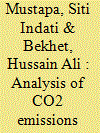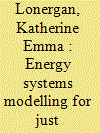|
|
|
Sort Order |
|
|
|
Items / Page
|
|
|
|
|
|
|
| Srl | Item |
| 1 |
ID:
150781


|
|
|
|
|
| Summary/Abstract |
The demand for transport services is expected to rise, causing the CO2 emissions level to increase as well. In Malaysia, the transportation sector accounts for 28% of total CO2 emissions, of which 85% comes from road transport. By 2020, Malaysia is targeting a reduction in CO2 emissions intensity by up to 40% and in this effort the role of road transport is paramount. This paper attempts to investigate effective policy options that can assist Malaysia in reducing the CO2 emissions level. An Optimisation model is developed to estimate the potential CO2 emissions mitigation strategies for road transport by minimising the CO2 emissions under the constraint of fuel cost and demand travel. Several mitigation strategies have been applied to analyse the effect of CO2 emissions reduction potential. The results demonstrate that removal of fuel price subsidies can result in reductions of up to 652 ktonnes of fuel consumption and CO2 emissions can be decreased by 6.55%, which would enable Malaysia to hit its target by 2020. CO2 emissions can be reduced significantly, up to 20%, by employing a combination of mitigation policies in Malaysia. This suggests that appropriate mitigation policies can assist the country in its quest to achieve the CO2 emissions reduction target.
|
|
|
|
|
|
|
|
|
|
|
|
|
|
|
|
| 2 |
ID:
125808


|
|
|
|
|
| Publication |
2013.
|
| Summary/Abstract |
This work investigates the interaction between wind power and electricity markets. The paper is focused on balancing markets pricing policies. The proposal of a new imbalance price scheme is included and conveniently evaluated. This proposed scheme tries to minimise the use of ancillary services to compensate for deviations in searching for a more efficient market design. The effectiveness of imbalance prices as market signals is also examined, and policy recommendations regarding imbalance services are discussed. Two test cases are included that analyse the participation of a wind power producer in the Spanish electricity market using a stochastic optimisation strategy. For this purpose, the uncertainty of the variables is considered, i.e., wind power production and prediction, intraday and imbalance prices. Test cases were run with real data for 10 months, and realistic results are presented along with a hypothetical test case. The regulation of the imbalance prices may not be adequate for the Spanish electricity market because an error drop is not sufficiently encouraged. Therefore, we suggest the application of a new imbalance price scheme, which includes an additional constraint. The conclusions of this paper can be assumed to be general policy recommendations.
|
|
|
|
|
|
|
|
|
|
|
|
|
|
|
|
| 3 |
ID:
176722


|
|
|
|
|
| Summary/Abstract |
The UK has some of the worst performing residential buildings in the EU from an energy efficiency perspective. Natural gas remains a dominant feature of existing and new-build housing with strong historical, technical, and social barriers to change. Consequently, the residential sector is responsible for significant shares of national emissions and has a strong role to play under ambitious net zero targets.
|
|
|
|
|
|
|
|
|
|
|
|
|
|
|
|
| 4 |
ID:
192792


|
|
|
|
|
| Summary/Abstract |
Policymaking increasingly targets an energy transition that is not only low cost and low carbon, but also just. While energy system models have been useful policymaking tools towards achieving the first two objectives, it is yet unclear to what extent they can also support a just transition. Here, we review 73 recent energy systems modelling studies using an analytical coding frame and observe a diversity of approaches to account for energy justice. While models do show promise in being able to support a just transition, especially in terms of assessing distributional outcomes, many of the approaches in the literature are poorly connected to current energy justice goals and discourses, decreasing the studies’ policy relevance and leaving policymakers with suboptimal planning support. Based on our results, we suggest eight actions for modellers to increase the policy relevance of their studies, which include more direct engagement with policy and research discourses, developing location-specific case studies, leveraging public participation in the modelling process, and considering asset decommissioning.
|
|
|
|
|
|
|
|
|
|
|
|
|
|
|
|
| 5 |
ID:
191219


|
|
|
|
|
| Summary/Abstract |
Hydrogen can be key in the energy system transition. We investigate the role of offshore hydrogen generation in a future integrated energy system. By performing energy system optimisation in a model application of the Northern-central European energy system and the North Sea offshore grid towards 2050, we find that offshore hydrogen generation may likely only play a limited role, and that offshore wind energy has higher value when sent to shore in the form of electricity. Forcing all hydrogen generation offshore would lead to increased energy system costs. Under the assumed scenario conditions, which result in deep decarbonisatiton of the energy system towards 2050, hydrogen generation – both onshore and offshore – follows solar PV generation patterns. Combined with hydrogen storage, this is the most cost-effective solution to satisfy future hydrogen demand. Overall, we find that the role of future offshore hydrogen generation should not simply be derived from minimising costs for the offshore sub-system, but by also considering the economic value that such generation would create for the whole integrated energy system. We find as a no-regret option to enable and promote the integration of offshore wind in onshore energy markets via electrical connections.
|
|
|
|
|
|
|
|
|
|
|
|
|
|
|
|
| 6 |
ID:
087895


|
|
|
|
|
| Publication |
2009.
|
| Summary/Abstract |
This article discusses the performance capabilities and the functionalities that naval radar systems need to operate in the littoral.
|
|
|
|
|
|
|
|
|
|
|
|
|
|
|
|
| 7 |
ID:
186416


|
|
|
|
|
| Summary/Abstract |
Hydrogen is a promising supplement in future energy systems with high penetration rates of renewable energy (RE) generation. As conversion technology between the two secondary energy carriers, hydrogen and electricity, particularly grid-connected electrolysers, have a role to play. During the market ramp-up, grid-connected electrolysers could cause unwanted side-effects through inducing additional CO2 emissions in the power sector. Since the reduction of CO2 constitutes the overall goal, a simultaneity obligation between RE generation and hydrogen production is discussed to prevent indirect emissions from an electrolyser's energy consumption. The paper presents a model framework including a mixed-integer linear program and a Markov chain Monte Carlo simulation for stochastic electricity prices to assess a grid-connected electrolyser's dispatch. Within a case study of the German electricity market, the effect of simultaneity on the dispatch is assessed. The results show that simultaneity reduces the CO2 emission intensity of hydrogen while constraining profits. The choice of the simultaneity interval length affects the electrolyser's average contribution margin from hydrogen production and the corresponding profit at risk, which results from fluctuating RE generation. Regulations aiming at the interface between hydrogen and electricity must consider the trade-off between economic viability, full load hours, and associated emissions of electricity-based hydrogen.
|
|
|
|
|
|
|
|
|
|
|
|
|
|
|
|
| 8 |
ID:
088249


|
|
|
|
|
| Publication |
2009.
|
| Summary/Abstract |
Heat cooperation between industries and district heating companies is often economically and environmentally beneficial. In this paper, energy cooperation between an integrated Swedish pulp and paper mill and two nearby energy companies was analysed through economic optimisations. The synergies of cooperation were evaluated through optimisations with different system perspectives. Three changes of the energy system and combinations of them were analysed. The changes were process integration, extending biofuel boiler and turbine capacity and connection to a local heat market. The results show that the single most promising system change is extending biofuel and turbine capacity. Process integration within the pulp and paper mill would take place through installing evaporation units that yield less excess heat but must in this particular case be combined with extended biofuel combustion capacity in order to be beneficial. Connecting to the local heat market would be beneficial for the pulp and paper mill, while the studied energy company needs to extend its biofuel capacity in order to benefit from the local heat market. Furthermore, the potential of reducing CO2 emissions through the energy cooperation is shown to be extensive; particularly if biofuel and turbine capacity is increased.
|
|
|
|
|
|
|
|
|
|
|
|
|
|
|
|
|
|
|
|
|